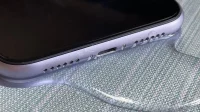If you drop your iPhone in the toilet or your dog’s water bowl, or regularly take it into the shower or pool, water is likely to accumulate inside its speaker grilles. The effect of water causes the sound played through the speakers to become softer and muffled, and removing this water is not an easy task. Luckily, there is an app for that.
Since the end of 2016, all iPhone models come with water protection. iPhone 7, 7 Plus, 8, 8 Plus, X, XR, and SE (2nd generation) are rated IP67 per IEC 60529 for a maximum depth of one meter for 30 minutes, while iPhone XS and later are rated IP68 with a maximum depth of two, four or six meters for up to 30 minutes, depending on the model.
When water enters the Apple Watch speakers, the watch will use the vibrating speaker to remove the water automatically or manually. However, Apple hasn’t provided a built-in way to remove water from the speakers. There are several iPhone patents for moisture removal, so one day we may see an iPhone with a water removal tool. Until then, we can simulate the Apple Watch function using Sonic, developer von Bruno’s app.
The App Store is littered with water jet apps, but most of them charge a subscription fee for something you can only use once or twice every few years. We’ve been using Sonic since it first came out and it hasn’t let us down yet.
Compatibility
DO NOT use this app if you have an older iPhone without a waterproof rating, such as an iPhone 5, 6, or 6s, as it may damage your speakers. For these older models, lay your iPhone on an absorbent, lint-free cloth with the speaker side down and wait for the water to come out. The gravity method also works for IP67 and IP68 iPhones, but Sonic will speed up the whole process.
Install the free Sonic app
Stylized as a V in a circle after the name in the App Store, the Sonic app has been updated for iOS 14 and still works great on iOS 15. It works on any iPhone running iOS 13 and later, as well as any iPad with iPadOS 13 and later.
There are a few in-app purchases available, but nothing you need for the main service of the app. You can pay to remove ads, get different signal styles, and save frequently used frequencies. Again, none of this is required to eject water.
- App Store Link: Sonic (Free)
Automatically remove water from your speakers
Sonic uses tones at low frequencies to expel water from speaker cabinets, much like other water expelling applications. The Water Lock feature on the Apple Watch uses a “series of tones”to clear the device of water, but Apple doesn’t specify which low-frequency sound waves are used. However, Sonic generates a tone that works most of the time.
To clean water from your iPhone’s speakers, tap the water drop icon in the center of the screen after opening the Sonic app. The Sonic will automatically play a tone at the right frequency, and you’ll need to turn up the volume on your iPhone so that the vibrations are enough to shake off the water. Then, lay your iPhone with the speakers facing down on an absorbent, lint-free cloth to collect the drips.
Depending on how much water is in there, you should see little drops of water coming out of the speaker grilles. You can even see some of them coming out of the front speaker next to the speaker. But even if you don’t see the water go away, your iPhone should sound normal again almost immediately. When you’re done, tap the water drop icon again to stop the sound.
The frequency displayed on the screen does not affect anything while the water drop icon plays a sound. Whether Sonic shows output frequency of 440Hz, 1080Hz or other frequency, the same sound will be played through your iPhone after pressing the water drop to play.
Remove water from speakers manually
You can also use a different frequency to clear water from your iPhone speakers. Instead of using the water drop icon, adjust the frequency manually. You can use the minus (–) and plus (+) signs to decrease or increase the frequency, or swipe up or down the screen to do the same at a faster pace.
We often see 165Hz references online, so somewhere between 150Hz and 200Hz is a good place to start. Turn up the volume and hit the Play button when you’re ready. With the frequency set at the sweet spot, the vibrating pressure and displacement sound waves will shake out the water. As with the water drop method above, use an absorbent, lint-free cloth to collect the drops. When you’re done, click Stop.
Other Ways to Remove Water from iPhone Speakers
Sonic is easy to use, and it’s a must-have app if you frequently use your iPhone near water or accidentally drop it in the toilet or other water sources more often than you’d like. Sonic isn’t the only way to remove moisture from iPhone speakers – you can also use a shortcut or website, as shown in the video below.


